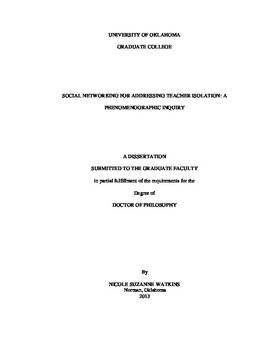| dc.description.abstract | Abstract
Given the recalcitrant effects of isolation and individualism and the barriers to organizational change, the purpose of this study is to put theory into practice by creating a social network for connecting in-service teachers, pre-service teachers and university faculty on one informal platform. Research has indicated a synergistic relationship between professional learning community development and technology integration, (Dexter, Seashore, & Anderson, 2002; Williams, Atkinson, Cate & O’Hair, 2008) and these components have been found to be mutually influential in the support of systemic school change and improved student success; however, the investment of billions of dollars in educational technology has yielded mixed results in terms of impact on teacher isolation. To reveal initiatives that contribute to the development and sustainability of a systemic change process, a closer examination of a new, enhancing experience that includes various stages of teacher development is warranted.
This perspective-seeking study monitors individual support within a social network. This study employs a phenomenographical design in order to more fully understand the lived experiences of twenty teachers in their use of online social network as well as teacher perceptions of the effects of the online community to overcome isolation. In creating a meta-network of professional learning communities, a culture was established and the lived experiences of the phenomenon were generated. From the data, five categories emerged as the collective lived experiences of the participants: affinity space, professional growth, outside expertise, discourse and collaboration. The five identified categories were classified into a hierarchy and relationships among and between the categories were identified. The outcome space identified the categories as a product of the lived experience but isolation was identified as the rationale for participation. The participants who self-identified as isolated were the most participatory in the online setting. This study identified ways to develop, strengthen, and extend professional learning communities beyond the constraints of time and place and have important implications on professional development, movements in reform and the development of new communicative technologies and their application to teaching and learning. | en_US |
